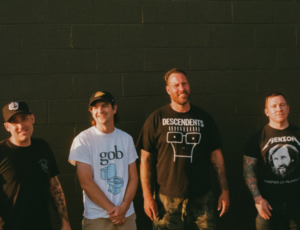It has been five years since the last Nine Inch Nails record, 2008’s The Slip, was released. The band’s principal member, Trent Reznor, has been otherwise occupied in the past half-decade with numerous other projects, including How To Destroy Angels (an apparently more collaborative effort than NIN) and The Social Network, the film soundtrack project which won Reznor his first Oscar. As a result of his interim work, the media has cast Reznor in a significantly different light than in his original ascent to fame. No longer the angry, pale, rail-thin kid the world saw in the days of The Downward Spiral and the Broken EP, he appears to us now as an adult who has seen the acceptance (if not the total understanding) of the mainstream music culture, and who has proven to have a remarkably sharp business mind. His 2008 instrumental double-album, Ghosts I-IV, was released for free online, yet he managed to make over $6M from it.
It is against this background that the new record, Hesitation Marks, is released this week.
Now, when an artist has a discography as deep as NIN’s (this being release #28), it’s only logical to take a quick look back to see how it compares to the previous releases. Upon an initial listening, Hesitation Marks clearly fits into the trend of post-2000 NIN records. The feeling is less hopeless than that of the ’90s records, shifting the negative feelings into more of a cultural/political sphere than a personal one. The emotional value is still there, but it’s expressed in a more mature voice, taming some of the rawness, yet maintaining a lot of genuineness.
Part of that authentic impression is the fact that Reznor has not stopped moving and experimenting. Clearly he’s working from the benefit of lesson learned while creating Ghosts, which contains some of his most left-of-centre musical creations, stemming from a spirit of unbridled artistic exploration. This same spirit can be heard in a few distinctive features of this record. From start to finish, Hesitation Marks features some of the most intricate and inspired rhythms I’ve heard. Reznor achieves this not by using weird and contrived musical mathematics, but rather a careful and detailed hand in designing and choosing multiple sounds and arranging them in unexpected ways. It occurred to me early on that any kid with some basic music software could approximate what’s heard here, yet they would be miles away from what Reznor has actually achieved from the listener’s perspective.
The truth is that Reznor is a top-notch record producer. It is not often the best artistic choice for a beginning recording artist to self-produce their debut album. Most songwriters are too close to their compositions – they simply lack the objective ear to be able to make sound decisions about what they should do with them, especially early in their careers. Yet, 1989’s Pretty Hate Machine displayed Reznor’s exceptional ability to listen to his own work and know exactly what must be done to make it what it is supposed to be.
This perfectionistic, big-picture approach to making records is what allows one of Hesitation Marks’ most distinctive – not to mention surprising – aspects to emerge: its pleasantness. We’ve come to expect harshness, an ugly, mechanical sound that speaks to something deep within. Instead, there’s a sense of calm here. The vocals aren’t pushed hard; if he’s not singing melodically, he’s speaking softly and soberly, sometimes even whispering. Guitars are seldom used, as compared to the more rock-oriented The Slip, and they lack the usual feeling in NIN’s music – that is, that they want to drag the listener kicking and screaming to a horrific death by chemical burning. Overall, the sound is uncorrupted by effect processing, resulting in a very pure, yet detailed musical composition.
However, that objective ear of Reznor’s does have a downside in the area of emotional expression. Lyrics have never been a great strength of his, and in contrast to Billy Corgan, a contemporary and (in my view) a good artistic comparison, Reznor is not a “complete package” songwriter. His main strength seems to be as an arranger, rather than a poet. This record is no exception, though this time there are no examples where the lyrics distracted me from the music. That said, the statement made in the purity of sound and the care in composition should be recognized: peace has been introduced into NIN’s vocabulary. There’s no more need to throw around mic stands or beat your head into the microphone to make your point.
This, perhaps more than many other of Reznor’s records, stands up to a multi-layered listening. It is clearly a very patiently crafted record which bears an extremely mature aesthetic. The details are attended to in a fashion that brings out the absolute best that the core songs have to offer. On the surface, Hesitation Marks is a worthy product to be consumed, yet if one listens deeper, there is a great deal of interesting material to find.










